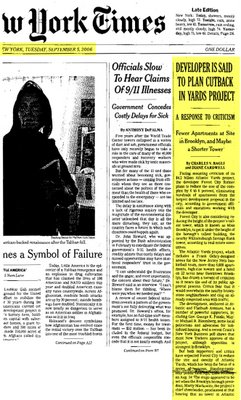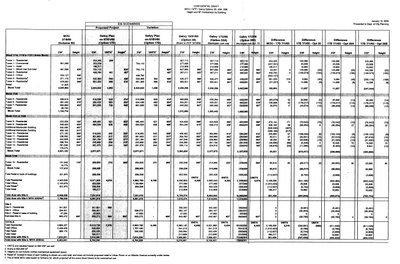The Atlantic Yards Final Environmental Impact Statement (FEIS) is out, but prior to any analysis, I'll attempt to correct two prevailing myths. The first concerned the source of the Design Guidelines.
 Forest City Ratner twice this year has garnered headlines and praise for reducing the size of the Atlantic Yards project in small increments, the most recent officially announced today.
Forest City Ratner twice this year has garnered headlines and praise for reducing the size of the Atlantic Yards project in small increments, the most recent officially announced today.
But most of those cuts were envisioned all along, which suggests that the reductions were more tactical than anything else.
(Right, the 3/31/06 announcement.)
Indeed, a document acquired in a Freedom of Information Law (FOIL) request from the Department of City Planning (DCP) shows that the current proposed scale--about 8 million square feet--nearly matches a chart presented to DCP on 1/12/06, as do the heights of most of the buildings. (The document I accessed was stapled to an email from a Forest City Ratner staffer to DCP.)
 In other words, we got played. The project, announced at about 8 million square feet in December 2003, was increased to 9.132 million square feet in July 2005, and was cut by the developer on 3/31/06 to 8.659 million square feet.
In other words, we got played. The project, announced at about 8 million square feet in December 2003, was increased to 9.132 million square feet in July 2005, and was cut by the developer on 3/31/06 to 8.659 million square feet.
Response to criticism?
In fact, the New York Times got played as well, offering its prestige to front-page article 9/5/06 that leaked news of an emerging scaleback of six to eight percent. The Times didn't point out that the rumored cut--the biggest news on the planet that day, apparently--would only bring the project back to square one.
It suggested the cuts were a "response to criticism" rather than a tactic. Nor had it or any news outlet found the document that explained how it was all in the cards.
But it was. Architects produce multiple versions of the same plan, and Frank Gehry had produced several options to present to the Department of City Planning on 1/13/06.
What happened next? Nothing obvious. But as the chart below shows, the cuts in building sizes announced 3/31/06 were already on the table. And most of the cuts recommended in September by the City Planning Commission--and then quickly "accepted" by the developer--were already on the table, as well.
(Click to enlarge)
[As noted by Matthew Schuerman in his follow-up, the current plan most closely matches Option 20B, and the planning commission didn't even take up Forest City Ratner on an option to cut Miss Brooklyn 25 feet, to 595 feet.]
CPC recommendations?
 Yesterday, the FEIS stated that the City Planning Commission (CPC)"made a number of recommendations with respect to the modification of the project program that was the subject of the DEIS." That refers to the CPC letter.
Yesterday, the FEIS stated that the City Planning Commission (CPC)"made a number of recommendations with respect to the modification of the project program that was the subject of the DEIS." That refers to the CPC letter.
A close look at the DCP chart shows that, for example, cuts on Buildings 2 and 8 announced on 3/31/06 were already envisioned. And the CPC's recommendations for cuts on buildings 3 and 6 matched plans already established.
One of the few changes that was not in the cards involves a cut in the building planned for Site 5, home of P.C. Richard/Modell's. Announced at 404 feet, and with no plans to cut it, it was reduced to 350 feet on 3/31/06 and to 250 feet in the CPC recommendation, partly because it would block views of the Williamsburgh Savings Bank.
A predictable strategy
Ron Shiffman, a former member of the City Planning Commissioner and a current member of the Develop Don't Destroy Brooklyn advisory board, had it scoped from the start. As the Times reported:
Mr. Shiffman speculated that the small reductions being contemplated are “more of a show than a substantive reduction,” aimed at politicians who do not want to stop the project but do want to claim credit for having gained concessions from the developer. “This is similar to the playbook and strategy that Ratner has used for all of his developments,” Mr. Shiffman added. “I think this is predictable, and that they concluded that the politicians needed something to go back to their constituents with.”
Indeed, it's not just predictable, it's obvious.
Gehry, in response to criticisms about the plan last January, told an audience in Manhattan, "It's coming way back."
Actually, it came back only a few fractions. But Gehry knew that various scalebacks were in the cards.
Could it come back more? Quite possibly. Surely there are other options.
Original document
(Below, the DCP document as originally scanned, before some cuts and highlighting.)

 Forest City Ratner twice this year has garnered headlines and praise for reducing the size of the Atlantic Yards project in small increments, the most recent officially announced today.
Forest City Ratner twice this year has garnered headlines and praise for reducing the size of the Atlantic Yards project in small increments, the most recent officially announced today.But most of those cuts were envisioned all along, which suggests that the reductions were more tactical than anything else.
(Right, the 3/31/06 announcement.)
Indeed, a document acquired in a Freedom of Information Law (FOIL) request from the Department of City Planning (DCP) shows that the current proposed scale--about 8 million square feet--nearly matches a chart presented to DCP on 1/12/06, as do the heights of most of the buildings. (The document I accessed was stapled to an email from a Forest City Ratner staffer to DCP.)
 In other words, we got played. The project, announced at about 8 million square feet in December 2003, was increased to 9.132 million square feet in July 2005, and was cut by the developer on 3/31/06 to 8.659 million square feet.
In other words, we got played. The project, announced at about 8 million square feet in December 2003, was increased to 9.132 million square feet in July 2005, and was cut by the developer on 3/31/06 to 8.659 million square feet.Response to criticism?
In fact, the New York Times got played as well, offering its prestige to front-page article 9/5/06 that leaked news of an emerging scaleback of six to eight percent. The Times didn't point out that the rumored cut--the biggest news on the planet that day, apparently--would only bring the project back to square one.
It suggested the cuts were a "response to criticism" rather than a tactic. Nor had it or any news outlet found the document that explained how it was all in the cards.
But it was. Architects produce multiple versions of the same plan, and Frank Gehry had produced several options to present to the Department of City Planning on 1/13/06.
What happened next? Nothing obvious. But as the chart below shows, the cuts in building sizes announced 3/31/06 were already on the table. And most of the cuts recommended in September by the City Planning Commission--and then quickly "accepted" by the developer--were already on the table, as well.
(Click to enlarge)
[As noted by Matthew Schuerman in his follow-up, the current plan most closely matches Option 20B, and the planning commission didn't even take up Forest City Ratner on an option to cut Miss Brooklyn 25 feet, to 595 feet.]
CPC recommendations?
 Yesterday, the FEIS stated that the City Planning Commission (CPC)"made a number of recommendations with respect to the modification of the project program that was the subject of the DEIS." That refers to the CPC letter.
Yesterday, the FEIS stated that the City Planning Commission (CPC)"made a number of recommendations with respect to the modification of the project program that was the subject of the DEIS." That refers to the CPC letter.A close look at the DCP chart shows that, for example, cuts on Buildings 2 and 8 announced on 3/31/06 were already envisioned. And the CPC's recommendations for cuts on buildings 3 and 6 matched plans already established.
One of the few changes that was not in the cards involves a cut in the building planned for Site 5, home of P.C. Richard/Modell's. Announced at 404 feet, and with no plans to cut it, it was reduced to 350 feet on 3/31/06 and to 250 feet in the CPC recommendation, partly because it would block views of the Williamsburgh Savings Bank.
A predictable strategy
Ron Shiffman, a former member of the City Planning Commissioner and a current member of the Develop Don't Destroy Brooklyn advisory board, had it scoped from the start. As the Times reported:
Mr. Shiffman speculated that the small reductions being contemplated are “more of a show than a substantive reduction,” aimed at politicians who do not want to stop the project but do want to claim credit for having gained concessions from the developer. “This is similar to the playbook and strategy that Ratner has used for all of his developments,” Mr. Shiffman added. “I think this is predictable, and that they concluded that the politicians needed something to go back to their constituents with.”
Indeed, it's not just predictable, it's obvious.
Gehry, in response to criticisms about the plan last January, told an audience in Manhattan, "It's coming way back."
Actually, it came back only a few fractions. But Gehry knew that various scalebacks were in the cards.
Could it come back more? Quite possibly. Surely there are other options.
Original document
(Below, the DCP document as originally scanned, before some cuts and highlighting.)

Comments
Post a Comment